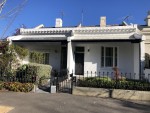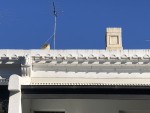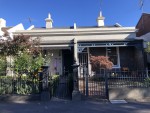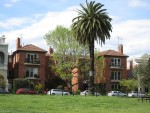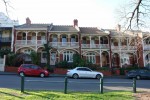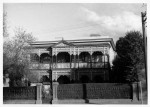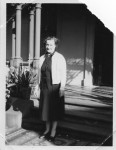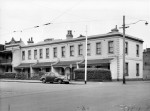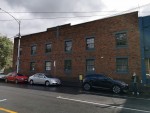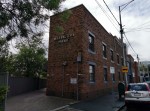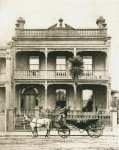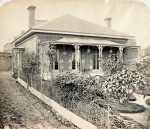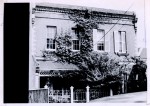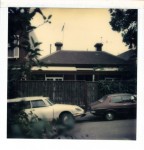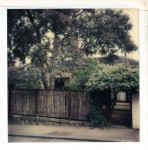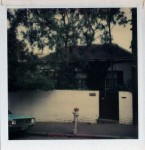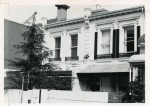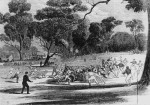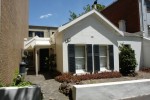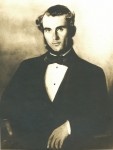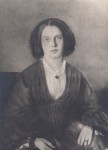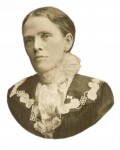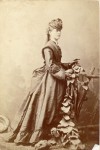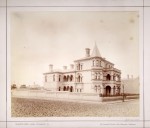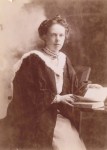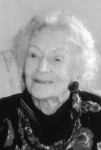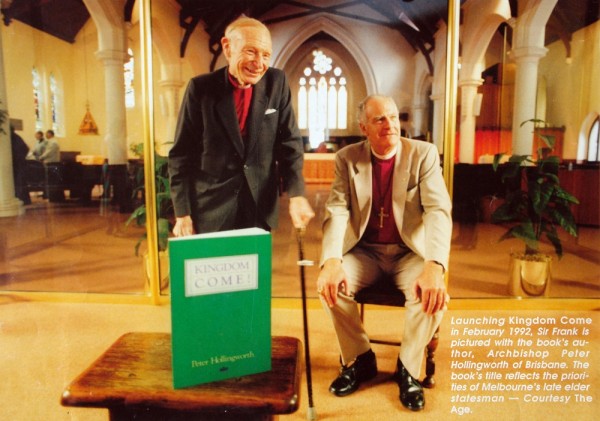Archbishop Frank Woods and his wife Jean were residents of East Melbourne from 1957 to 1977 when they lived at Bishopscourt. Their daughter Clemence was six when they arrived in Melbourne from England for her father to take up his appointment. In October 2008 Clemence gave a delightful talk to Historical Society members about growing up at Bishopscourt. Her talk is illustrated in our Bishopscourt Gallery.
However, there is much more to be said about Frank Woods, and Jean, than can be included in one evening's programme about Bishopscourt.
However, perhaps Frank's influence on the church in Australia can be best summed up by Bishop James Grant in his introduction to the Frank Woods Endowment Centenary Appeal:
More on Frank and Jean Woods can be found in the following tributes.
Archbishop Sir Frank Woods (1907-1992)
A tribute compiled by Anglican Media
Originally published in 1993 by Anglican Media Melbourne and reproduced here with permission:
http://www.melbourne.anglican.com.au/
Standing on the Christ-ward side of our lives
It is my privilege to speak of Frank Woods for a few minutes as I knew him, while we all continue to think of him each with his or her own memories, and give thanks to God.
I first became aware of Frank Woods almost 60 years ago when he was chaplain of Trinity College, Cambridge; his youngest brother was a close friend and Frank was one of the college chaplains who gave unfailing support to the Student Christian Movement, where Christians from a variety of church backgrounds learnt to recognise each other, and learnt much about the message and mission of Christ and his Church in the world.
It was therefore no surprise when years later in Melbourne and Australia we knew Frank Woods as a leader in the ecumenical movement in this state and in the Australian and World Council of Churches. He taught us all that you must recognise in the other man or woman, one whom God has recognised, that you must rejoice that Christ has called into his service men and women of diverse races and traditions, that in the gift of the Holy Spirit we all belong to the one family of God. In Australia he inaugurated a new era of better relations between the Anglican Church and the Church of Rome, beginning with his call on Archbishop Mannix soon after his arrival; and I often thought that he understood better than some of us did what we were trying to do in bringing three churches together in the Uniting Church. Like many of us he regretted that the Anglican Church was not a party in those discussions, although thanks to his initiative we had Anglican observers throughout.
My second picture is of Frank as senior chaplain to the British Army in Northern Ireland at the end of World War II. Our closer friendship dates from then, now almost 50 years ago. We saw much of him in our home. He even came from time to time to hear me preach, a singular act of friendship. He persuaded me to join with him in conducting some Bible studies for the chaplains of all denominations stationed in that area. We were required to work from the text of the Bible alone, for the chaplain on active service might only have two books with him, a New Testament, preferably but not necessarily in Greek, and his prayer book.
It was therefore no surprise to me when we met again in Melbourne to find in Frank Woods a strong supporter for better theological education for the clergy and for better instructed people. Nor was it a surprise to see him present at schools of theology, humbly learning afresh truths in which his life was deeply embedded.
My third picture is of Frank Woods, companion, friend and pastor; entertaining companion whose company was enjoyed by so many and who was so readily accepted by young people; loyal friend; and pastor. The instances are too many and, in some ways, too intimate to recount. Wherever you went, whatever you were asked to do, you knew that Frank was encouraging you and supporting you with his prayers. He once gave me a book which he had read with some satisfaction, entitled The Shadow of the Galilean. He lived his life in the shadow cast on our ways by that Galilean, Jesus of Nazareth; or it might be better to say, in the light cast on our ways by that same Jesus, and he in turn shed light on our ways. He stood on the Christ-ward side of our lives.
I last saw him not much more than 24 hours before he died. As I came away I reflected that the next day would be Advent Sunday; and I remembered the opening words of a great sermon I had heard on Advent Sunday 26 years ago in a church in Heidelberg in Germany: "God would make a new beginning with you; and would have you make a new beginning with him. That is the message of Advent."
Thank God, that message was fulfilled in the life of Frank Woods last Sunday.
Dr Davis McCaughey
former Governor of Victoria
An Israelite in whom was no guile
The portrait of Sir Frank Woods in the Chapter House is a remarkable example of an artist's ability to portray the inner being of his subject, and it has a close affinity with that of his mother which was at the chapel door of his study in Bishopscourt. One suspects that the deep spirituality shining in them both stems from their illustrious Quaker descent.
Steeped in Anglicanism as he was, the archbishop knew all the collects by heart and his selection of one or other of these to open a meeting was usually incredibly apposite and drew you at once into his realm. Behind all this there was a wonderful humility revealed in his unbelievable patience at small meetings in the early years when the assertiveness of another so often prevailed.
Nevertheless, there was an arresting authority about the man, more powerful because it was never claimed. One can never forget being present when a regular army chaplain appeared before the archbishop at his own request; very little was said, but the man found himself committed to starkself-disclosure, and went off from the interview to become one of the valuable members of the Army team.
All this was part of a presence which one could not ignore. Wearing clerical robes in an unselfconscious way so typical of English clergy, he might well have been born in them. He always produced a sense of occasion, not only at a great service, but also in a meeting of a small group. Some of his synod sermons were exciting, in spite of the spectre of the debates which would follow and which he appeared to find so tedious.
Sir Frank was particularly sensitive to the opinions of others and was always ready to hear their argument and then to be fair in his judgments. Always open to new ideas, he appeared to have read all the latest books and was keen to discuss them, although he was observed to defer to academics. Despite its rejection in England, he showed great courage in leading the diocese to adopt the Paul Report involving a radical change in the tenure of clergy.
In a sense the archbishop was an Israelite in whom was no guile. One suspected that he knew very little of the frailty of humankind, always believing the best of others, and himself incapable of anything mean. Occasionally he referred to the existence of fundamentalists and, to him, these seemed to represent evil at its worst. They were shadowy figures never to be identified and obviously his pious hope was that none of his friends would ever be so diagnosed.
No doubt others will write from firsthand experience of the remarkable warmth of Sir Frank's ecumenical relationships, his encouragement of liberal theological thought, together with his marked influence on liturgical practice within his own diocese. Some have said that he sought to emulate his distinguished uncle Theodore Woods, sometime Bishop of Winchester, but whatever his model, he increased our indebtedness to the English Church by bringing to us a rich tradition of spirituality, flair, and a goodness which was uncontrived.
Archdeacon John Moroney
former Archdeacon of Melbourne
In mind and spirit he never grew old
(Funeral address delivered by Archbishop Keith Rayner on December 4, 1992.)
The Most Reverent Frank Woods KBE, MA, DD, LLd. Born April 6, 1907 Died November 29, 1992
Now I know only in part; then I will know fully, even as I have been fully known (1 Corinthians 13:12).
There is a piece of advice which generally holds good: if you want a big funeral, die young. Frank Woods did not follow that advice. He died at the age of 85; he had been retired for 15 years. The presence of this great congregation today is eloquent testimony to a man who, though frail in body, in mind and spirit never grew old.
Great men leave many memories behind, and the stories accumulate as the years go by. All of us will have our memories of Frank Woods. My earliest recollection is more an impression than a memory. When he was enthroned as Archbishop of Melbourne in 1957 I was a young bush brother in southern Queensland. The Diocese of Melbourne, dare I say it?, was regarded by us Queenslanders as a hit stuffy then! But I still remember the thrill at reading Frank's enthronement sermon. To me in the Queensland bush it seemed a breath of fresh air. To those in this cathedral it must have been electrifying. Already it set the pattern for his episcopate: a strong biblical foundation, the context of a challenging world, a broad catholicity, the need for a pastoral, a praying and an educated priesthood, the importance of the laity, the call to ecumenism. It was all there; and Melbourne knew it had a spiritual leader and a true Father-in-God.
That impression from afar gives place to a vivid and more recent memory - the occasion of the consecration of Peter Hollingworth and Robert Butterss as bishops of the Church of God in 1985. Frank Woods had already been retired for eight years. He had suffered since retirement some severe setbacks to health; he was frail and already stooped. The old man laboriously climbed into the pulpit. And then the voice rang out, powerful and confident, with all the mental and spiritual vigor of a man half his years. When he finished, the cathedral erupted into spontaneous applause. Now I have to say that I have reservations about applause for sermons. It might be fine when the sermons are good, but I fear most sermons would be greeted with deafening silence! But that night, it was right.
What was it about that sermon? Partly, I think, the congregation sensed that this might he the last grand occasion of that kind for this great and beloved patriarch. But the sermon itself was vintage Frank
Woods. He spoke very plainly about things that were wrong in the world and in the Church. He was thoroughly realistic about the privatisation of religion and the marginalisation of the Church. But he did not stop there. He pointed to the signs of hope, the things, he said, which lifted him out of the despondency into which he sometimes fell. We all went away cheered and encouraged by this great-hearted servant of Christ who faced the agony, did not know all the answers, but looked to the future with confidence and hope. It was not simply the words, but the man who gave them life.
This was what his clergy and people found so encouraging about Frank. He did not look at the world through rose-colored spectacles. He had been a chaplain in the War, and he knew the depths of horror into which human beings can descend. He could not stand cant. He hated intellectual dishonesty. He did not pretend that there were pat answers to nagging and perplexing questions. He knew that "now I know only in part", and that "we walk by faith, not by sight". So he was always exploring, always pondering the Scriptures more deeply, always looking to be stimulated by the insights of some new book or the illuminating thoughts of an interesting companion.
Last week, just a few days before his death, I visited him at the hospital and said the office of evening prayer with him. The lesson set, from Revelation 20, was not one I would have chosen. It was the passage about death and Hades being thrown into the lake of fire, described as the second death. It is a difficult and puzzling passage. Frank was puzzled, and he said so. Puzzled, but not anxious. Even in his final weakness he was still searching: "Now I know in part; then I will know fully, even as I have been fully known".
For Frank Woods there were always new questions to be asked, new depths of the ultimate mystery to be plumbed. Most of us do our really creative thinking while we are young, and live on the capital as we grow old. Not so with Frank. Some of his freshest and finest addresses were given in his retirement. One he gave in a retreat which I attended, entitled 'Jesus the Layman'. It really stemmed from his experience of being stripped of the trappings of office as archbishop. In effect, in daily life, he found himself for the first time since he was a young man a layman again. In reflecting on this experience of losing the props and trappings of high office he awoke to the significance of Jesus the layman.
There are some, not least among the clergy, who start life being fresh and creative, even radical. They come to a certain point,usually in early middle age, and get stuck there. Their early freshness and openness becomes a hardened conservatism. The world goes on, but they become bogged down and backward-looking. There are not many of us who go on, creative and forward looking, to the end. Frank Woods was one of those; and that was why he could inspire and encourage the young as well as the old all through his life.
If we can learn from Frank Woods the secret of this, we shall have learned something very precious about life. I think the secret was that he was firmly rooted in the really essential things. In a way, he was an unlikely archbishop for modern Australia. He was so English, so rooted in the traditions of ecclesiastical aristocracy with a father, an uncle and eventually a brother as bishops, so shaped by the classic formation of a bishop for the Established Church that he could hardly be right for the rough-and-tumble and the supposed egalitarianism of Australian life. It was the classic English pattern: curate at Portsea, that training ground for English bishops; chaplain at Trinity College, Cambridge; vice-principal of Wells Theological College, chaplain to the Forces, vicar of the large parish of Huddersfield, chaplain to the King and finally suffragan bishop of Middleton. Yet he loved Australia. He identified with this country. It became home for him and his family, and he chose to retire and to die here.
In all this he was deeply rooted, but he was rooted in the essence of things, not in their outward trappings. He was rooted in a deep personal faith in Jesus Christ, so he could afford to question and explore the faith without fear of losing hold. He was quintessentially Anglican, so he could afford without anxiety to be thoroughly ecumenical. His English identity was secure, so he could afford to become enthusiastically Australian. He was grounded in the liturgy, so he could afford to be free and spontaneous in new forms of worship and at the same time to reject liturgical fussiness. He loved peace and hated the horrors of war, so he could afford to march on Anzac Day with old comrades without fear of being classed a warmonger. He was immersed in the great tradition of the catholic faith, so he could afford to be open to the new and, for example, to champion the cause of the ordination of women. I suspect that at the end he could let go peacefully knowing that the ordination of his daughter was free to proceed.
We saw in Frank Woods a man who was deeply secure. He did not need to be flattered or humored; there was no arrogance or vanity in him; there was no necessity to stay safely in a narrow rut. He could find the routine of administration tiresome and there were real problems in this area in his early years. lie could he impatient with hypocrisy or narrow-mindedness. He had no time for ecclesiastical politics. He knew there were many questions to which he had no answers. But he had no doubt about the God whom he trusted, or the certainty of his vocation as priest and bishop, or the responsibility to try to make the Gospel of Jesus Christ come alive not only for the people in the pew but for the whole world out there. We thank God for that 20 years he was given to us as a great Archbishop of Melbourne and for six years as a notable Primate of Australia.
But Frank Woods was not just a great archbishop. First and foremost he was a man, a Christian, a servant of the Lord. He was a devoted husband, sharing with Jean his life, his ministry, his love. Despite the frantic and constant busyness of his public life his family was always at the heart of his life. As a son devoted to his parents, as a husband giving of himself to his wife, as a father and grandfather delighting in his children and their children. Even as we thank God today for a life that was so rich in content and full in years, so that we would not want to hold him back within a body that could no longer serve his active and questing spirit, we share with his loved ones the grief of separation which death involves. To Jean, Theodore, David and Elizabeth, Richenda and Ian, Clemente and Stewart and all the family we offer our sympathy as we share your grief; and we surround you with our love which is but a pale reflection of the much greater love of our Lord and God.
Frank has passed from our sight, and death is real. But for the Christian it is never the final reality. In one of his Easter sermons, Frank spoke of "life's diminishments", "the gradual stripping from us of all self-reliance in order that we may be centred wholly upon God". Thankfully, Frank was in mind and spirit alert to the end. He had his last communion just an hour or two before his death. But his body had worn out; his strength was stripped away. We would not want to hold him like that. Rather we can rejoice that in the resurrection life, which is so central to his faith and the faith of the Church, all that is partial and imperfect is done away, the questions are answered, the mystery is made plain. "Now I know only in part; then I will know fully, even as I have been fully known". Today we rejoice that Frank Woods, Christian, bishop, knight of the realm, seeker for truth, knows even as he is known.
Keith Rayner
Archbishop of Melbourne
Fire within his wiry frame
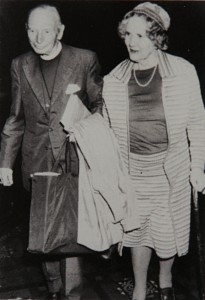 Sir Frank and Lady Woods pictured after the service celebrating Sir Frank's 80th birthday at St Paul's Cathedral - Courtesy Herald & Weekly TimesFrank Woods was a pioneer in many fields. He led Victoria's six dioceses into becoming a genuine province of the Australian Anglican Church, in spite of serious obstacles of law and personalities. Melbourne, Ballarat, Bendigo. Wangaratta, Gippsland and St Arnaud did very few things together in 1957.
Sir Frank and Lady Woods pictured after the service celebrating Sir Frank's 80th birthday at St Paul's Cathedral - Courtesy Herald & Weekly TimesFrank Woods was a pioneer in many fields. He led Victoria's six dioceses into becoming a genuine province of the Australian Anglican Church, in spite of serious obstacles of law and personalities. Melbourne, Ballarat, Bendigo. Wangaratta, Gippsland and St Arnaud did very few things together in 1957.
He invited the diocesan and assistant bishops to meet with him for one or two days at least once a year. He offered the other dioceses access to several facilities which Melbourne provided. For example, we were invited to send newly-ordained clergy to Melbourne for post-ordination training. Similarly he made it possible for his newly-ordained men to have a few years' experience in rural ministry, with no strings attached. If the country diocese wished to retain them and they wished to stay, that was provided for in the plan.
The 'bush' was also invited to send candidates for ordination to his selection conferences, which was another innovation in Australia. This helped greatly to break down the wicked notion that someone rejected by the city might be 'good enough for the country'. He realised that the boot might even be on the other foot. The country priest, isolated by distance from his brother clergy, has to handle, or fail to do so, all the problems of ministry, without the help of close neighbors, whereas the city priest is surrounded by possible helpers.
Country bishops and clergy were invited to the new departmental opportunities which he brought into existence. For too long Australian Anglicans had relied on England to supply their bishops and other leaders. Though very English himself, he drew the sting of that fact, by becoming thoroughly at home in Australia. When he became Primate in 1971, he travelled very widely to all our dioceses, and also to other countries of the Pacific area. He made the Primacy a servant of the whole Australian Church.
This did not mean that he was only the servant of Anglicans. From the first, he stood for the vital importance of the ecumenical movement.
He quickly saw the importance of the eucharistic congress of the Roman Catholic Church in Melbourne in 1973. His personal relationship with the Roman Archbishop of Melbourne was warm and friendly. He joined in organising a representative meeting in the Melbourne Town Hall at the time of the congress and took a positive part in the seminar on ecumenism at Monash University.
The Town Hall meeting was packed. The night was stiflingly hot. The audience relied on ceaseless movement of their fans to keep awake. The effect of this was mesmeric to those on the platform. The Cardinal was the chief speaker and he spoke for over an hour. Frank discarded his own notes and spoke crisply and informally for about ten minutes. He created great interest when he asked the Roman Catholics present to raise their hands. They were greatly outnumbered by the rest of us. He commented that this showed that we now had an opportunity to know and achieve a greater catholicity than we had ever known before. Enthusiastic and prolonged applause greeted this observation.
The warmth of his personality was illustrated on Spencer Street Station one evening, when he discovered that he and one of our daughters were boarding the same Sydney train. "What fun!" he exclaimed. In our family that became his affectionate alias.
In some ways he was a conservative, but quickly saw the most urgent needs and took well-considered action to meet them. However, he did not dictate the way that others should act. The day before he consecrated me as a bishop, I asked him for advice for a new-boy bishop. But he disclaimed any ability to do so. Later when I asked him his opinion on a plan for co-operation with the Methodist Church in the scattered area of Cann River, he encouraged me to proceed. Some months later he wrote again saying that he advised caution and delay. Since an appointment had already been made, I rang him at once and told him so. He laughed heartily and accepted the situation.
And there was fire within his wiry frame. At a meeting of Victorian bishops, other clergy and laity, to discuss the syllabus of the Council for Christian Education in Schools, one of the bishops was caustic about its 'moralising' content and language, which he sweepingly dismissed as "that stuff'". Frank sprang to his feet and indignantly reminded the meeting that the syllabus included the Lord's Prayer, the Ten Commandments and the Apostles' Creed. Did the bishop describe them as "that stuff'"? The pentecostal fire was in his spirit too.
So was courage. He was severely injured when knocked down by a tram in Collins Street. He and his family lost much of his library and personal possessions when the Beaconsfield house was destroyed in a bushfire – a baptism by fire indeed.
David Garnsey
Bishop of Gippsland, 1957-1974
A very good man...
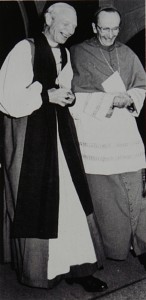 Leaving St Patrick's Cathedral after preaching there in April 1976, Archbishops Woods and Little share something of the Joy of the occasion. - Courtesy The Age
Leaving St Patrick's Cathedral after preaching there in April 1976, Archbishops Woods and Little share something of the Joy of the occasion. - Courtesy The Age
There was a time when the Church of England in Australia almost always looked for its bishops from England. Anglican schools similarly looked for headmasters overseas. This is no longer the case. As one of the last of the transported English headmasters, I am proud to write of one of the last of the English bishops.
Frank was one of those Englishman who immediately liked Australia and accommodated himself to it. In consequence he was almost immediately liked and trusted and even loved. Melbourne is a large and diverse diocese with many parishes and many Anglican schools. With the schools he felt himself particularly at home and enjoyed his visits to them. He inherited from his predecessors a well ordered organisation and a loyal community. His openness and natural friendliness, his simplicity and complete lack of pomposity, his readiness to listen even when he did not agree and the recognition that there was strength behind his humility, laid the basis for a great episcopate.
They were turbulent times, the '60s and '70s. It was a period of great social change and of moral values. He disliked some of what was happening, he disapproved of much of the laxness, but he never faltered or failed in sympathy. Loyalty was basic to him and remained so throughout his life.
The times were explosive. Population increased with the influx of new immigrants largely from Europe: Greeks, Italians and Dutch, as well as British. Numerically and in prestige the old dominance of the Church of England weakened, but new suburbs grew rapidly and had to be served. With the increasing prosperity and the demographic changes in age proportions, the demands of youth to be heard became strident and all the forms, desires, beliefs, convictions of the old world were passing away, never to return, or so it seemed. It was hard for those who had lived in and enjoyed the past, to adjust. It was particularly hard for one who bore responsibility for leadership in the church. There followed the dramatic change of view in the role of women in the community, a change not yet fully recognised, and especially significant in the demand for the ordination of women.
There were other questions too. The church, which had generally seemed to be the bastion of conservatism and establishment, was called upon as never before to lead in social reform in the battle against racial discrimination in the defence and support of underprivileged people all over a world brought closer by the dramatic developments of communication. The commitment to practical help inevitably brought the churches in touch with revolutionary political movements. Many Christians disliked and feared the association.
All these problems and more were what he had to face. He did not satisfy everyone; he even faced some criticism, but what he did was lasting, for he brought to the task himself. Above everything else he was the servant of Christ.
He was also blessed with his qualities of a good man through and through. I have mentioned humility. He never was even tempted to assume the superiority which his position might be thought to justify. He was loyal to Christ, to the Church, to his colleagues and to those others who relied on him, though they did not know him, as his friends knew him.
Finally he had courage. In the last several years of his life he was destined to suffer again and again continually. He endured the diminishing powers of his body and, at times, severe pain. He never let it defeat him: he never complained of the injustice of it: he drove himself to work in spite of it.
When Mr Valiant for Truth came to the river which we all must cross, he could say in certain faith: "My marks and scars I carry with me to be a witness for me that I fought this brother who now will be my redeemer." So be it.
Sir James Darling
Headmaster Geelong Grammar School
From "establishment" to radical critic
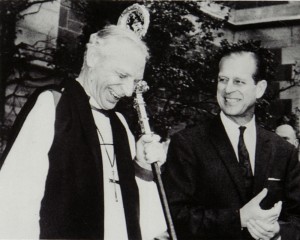 A right royal occasion. Sir Frank is pictured on the steps of St Paul's Cathedral - Courtesy Herald & Weekly Times
A right royal occasion. Sir Frank is pictured on the steps of St Paul's Cathedral - Courtesy Herald & Weekly Times
Frank Woods' appointment to Melbourne was unexpected. A majority of the Board of Electors was committed to the appointment of an Australian. But, when agreement could not be reached on a local candidate, Archbishop Geoffrey Fisher was asked to suggest some English possibilities. Fisher had made an extended tour of the Australian Church in 1950 and had been shocked by its narrow diocesanism. He made only one recommendation, that of the Bishop of Middleton, and this to its eternal credit, the board accepted.
The diocese to which Frank Woods succeeded in 1957 was well served by its clergy and specialised agencies. Though lacking the massive endowments of its Sydney sister, its resources had been well husbanded. However, its latent energy needed to be released and focussed. The new archbishop, fresh from involvement with the most forward looking elements in the Church of England, was peculiarly fitted to fulfil this role.
A survey of the diocese identified potential growth areas and a diocesan-wide 'forward move' was launched. A good financial response was achieved which allowed expenditure to be increased on clergy training, new area parishes and hospital and institutional chaplaincies. In tandem with this went a four-year study program entitled 'Forward-in-Depth'. Woods' episcopate was also marked by growth in ecumenical understanding and joint action. It saw increased participation in the Australian Council of Churches, and new ventures in industrial mission and in theological education through the United Faculty of Theology, and in personal and theological dialogue with Roman Catholics.
Woods' episcopate saw the Church move from its traditional role of 'hallowing the establishment' and providing care and carers through its institutions, to one of offering a more radical critique of society. On issues such as capital punishment, poverty, and Australian involvement in the Vietnam War, the Church in Melbourne, officially at least, was in the vanguard of public opinion.
Ecumenically, overseas influences were apparent as the impact of Vatican II was felt. Theologically, John Robinson's questionings in Honest to God were echoed in the 1967 episode of the 'Melbourne Agnostics'. Parochially, the Parish and People Movement influenced the course of liturgical change and the development of new pastoral strategies, especially in Christian initiation. The 1970s saw a decline in Sunday school enrolments, in formal youth work and in nominal adherents. But this was paralleled by a greater commitment at every level by those who continued to identify themselves as Anglicans.
Intellectually, theologically, ecumenically, pastorally and spiritually, he contended for an 'open' position. He encouraged a similar stance among his clergy through his ordination and retreat addresses, through a series of notable synod charges, and through sponsoring visits by leading contemporary theologians. And despite his essential Englishness he won and held the affection and trust of his diocese and community.
He retired in 1977, but continued an active ministry in demand as a preacher and retreat conductor. Always a forward thinker, he grew more radical with age and supported strongly the ordination of women to the priesthood. He will be remembered within the Australian Church for his ecumenical initiatives, his national outlook and his modelling of a relevant contemporary episcopacy: pastoral, collegiate and community orientated.
In adding a more personal appreciation of Frank Woods, I freely acknowledge its subjectivity. I was ordained by him; I served as his chaplain for four wonderfully happy and fulfilling years; and I was nominated and consecrated bishop by him. He was a dear friend and constant inspiration and remains the dominant influence in my ministerial formation.
Frank Woods the man
As has often been remarked, "Frank Woods was a natural aristocrat: the son, nephew and brother of English diocesan bishops." This was perfectly true and in addition he was endowed with many and great natural gifts. He could, and did, relate easily and naturally to the Establishment: he spoke their language; he was one of them.
But at the same time, there was in him no trace of arrogance; he could relate just as easily to the brash youngster, the frail elderly, the outback battler or the homesick migrant. Nowhere was this capacity more obvious than in his parish visitations, for which he was universally sought and at which he was eagerly welcomed. He commended himself by his evident interest, his enthusiastic engagement and his ready sense of humor. His integrity and his strong but uncomplicated faith, based on the Bible and the Book of Common Prayer were clear. Not surprisingly, his friendships were legion among both clergy and laity.
Frank Woods the pastor, preacher, teacher
The archbishop's first experience of ministry was between school and university when he spent some time in Cairo with his godfather, Bishop Gwynne, and taught at the diocesan grammar school. He might well have taken up teaching as his life's work. Instead, he opted for ordained ministry, but within his ministry it is for his pastoring, his teaching and his preaching that he will surely be best remembered.
His view of creation as the embodiment of God's love and humanity as its crowning glory sustained in him an abiding interest in, enjoyment of, and concern for nature, science, the arts; the whole range of human endeavour. He was a great encourager, a great sharer and, in trouble, sickness or grief a strong rock.
His intercession book was always full and he made time to pray systematically for all sorts and conditions. Two incidents illustrate his approach. On one occasion meeting a new ordinand for the first time, he floored him by saying, "You know I pray for you", as indeed he did. Again, when a lay reader prayed for "The Aboriginal Problem" he said, "Oh no, not the problem, but the people who create the problem and those affected by it."
Frank Woods valued and enjoyed his public Ministry of the Word. He ascribed a high priority to it in his program and he took great pains with his preparation for it. His enthronement sermons set a standard which was maintained throughout his whole episcopate and after.
Frank Woods the bishop
"An inspiring leader", "a leader who responded to challenges", "a visionary". These are three of the characteristics highlighted in press notices. They are all appropriate. I would want to add some others.
His capacity to be one step ahead – in modern terminology he was pro-active rather than reactive. He was prepared to take risks, especially with people. To the consternation of his staff he would often come up with come maverick candidate who more often than not justified the risk he had taken. He was enthusiastic – "Oh, let's" was a normal reaction in all sorts of situations, enhancing occasions or retrieving looming disasters.
He said, once, with perfect justification, that there was no one he hated. But he had some pet aversions: dogmatic illiberals, persistent raisers of points of order in synod, the faceless men who organised the election tickets for the synod factions.
He was a better administrator than he was prepared to admit, but his episcopate was most effective when he worked in tandem with Geoffrey Sambell and Bob Dann and the other regional bishops.
Mention has frequently been made of the importance of his family in his Christian formation. Just as central to his ministry was his own home base. The episcopal "household" was a reality and we ought never to underestimate how necessary was the support he received from Jean and his children and how willingly and generously this was given.
Asked on one occasion what he thought the primary tasks of a bishop was, Archbishop Michael Ramsey suggested, "bringing the people to a knowledge of God, helping the people to grasp the meaning of the Christian faith, witnessing to Christian principles in some of the conflicts of the day, leading the people in the way of prayer, helping in the cause of Christian unity."
Whether Frank Woods ever read this statement is doubtful. But as a summation of what he achieved in his ministry in this diocese and Church, it can hardly be bettered.
Bishop James Grant
"God has been very good to me ..."
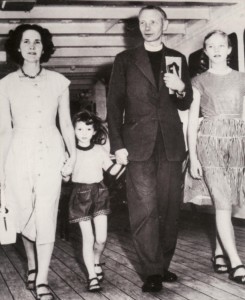 The Woods family arrive in Australia on December 11, 1957. Pictured above are Archbishop-elect Woods with his wife Jean and younger daughters Clemence and Richenda - Courtesy The Age
The Woods family arrive in Australia on December 11, 1957. Pictured above are Archbishop-elect Woods with his wife Jean and younger daughters Clemence and Richenda - Courtesy The Age
This tribute to the late Archbishop Sir Frank Woods is adapted, with permission, from an essay first published in Church Scene on June 2, 1977 to mark his retirement. The essay was written by Dr Robin Sharwood, using material gathered for this purpose by the editor of Church Scene. The essay is printed in full in the book Frank Woods: Sermons And Addresses (JBCE 1987).
First and perhaps foremost, is the archbishop's family. The family, and especially his own family, was the foundation upon which he built everything else.
But the archbishop's concern was not merely with his own immediate family, his wife and children. The Woods family is extraordinarily close-knit and spans the generations. The archbishop was conscious of all those generations and proud of them.
Well he might have been. He derived from a splendid Anglican family tradition. From both his parents Frank Woods received a rich Christian inheritance. When he first moved into Bishopscourt, forbidding and rather second-rate portraits of his Melbourne predecessors hung over the dining-room sideboard. After a decent interval Frank Woods replaced them with framed family engravings of the two famous Gurney sisters – his kinswomen, Elizabeth Fry and Hannah, Lady Buxton.
Following the example of his father, and supported by a wife whose commitment to the idea was as firm as his own, Frank Woods made Bishopscourt, Melbourne, a homely place, in the best sense, to all who visited it, and welcomed those visitors with unselfconscious ease and warmth into the life of his family, whatever that life happened to be when they called; having tea, perhaps, or playing tennis, or watering the garden, or discussing what next to do at the cottage in Upper Beaconsfield.
Whenever possible, the archbishop preferred callers to see him at home, rather than in his rather sombre little room at the cathedral (he insisted on giving over a much finer room to the dean). The interview might take place anywhere – in the study, over a pot of Twinings Earl Grey (his favourite tea); in the morning room, before the fire, with a tray of sherry; in the garden with the dogs. If any other member of the family were at home, the caller would almost certainly meet them too and, perhaps at the end of the discussion, the archbishop would take his visitor into the chapel "to say a prayer". It was a marvellous way to be a Father in God, even if it sometimes drove orderly secretaries to despair (especially when clergy began to discover that they could "beat the system" by presenting themselves at the door of Bishopscourt instead of making appointments through the office).
Surely one of the most indisputable aspects of the archbishop's life and ministry among us was the degree to which he was able, over a period of time, to identify himself deeply and genuinely with the Australian community. He remained an Englishman by birth and upbringing, by accent, manners, habits of speech and so on, but he had become an Australian by what he has termed "conversion" and recognised himself as such.
Both the archbishop and his wife developed a genuine love for the richness and variety of the Australian landscape. They travelled it from coast to coast, visiting almost every diocese. Here in Victoria, their country cottage at Upper Beaconsfield was very dear to them. The "conversion" process did not take place overnight. It was a long time maturing.
The archbishop once told one of his close associates that it was at Cambridge where he first met "the Church and the world".
He had been away to boarding school (Marlborough, his father's school), but it was Cambridge which opened his eyes. He became an undergraduate at Trinity College in 1926, and, in due course, after theological studies and ordination, its chaplain and a Fellow. A Trinity don of the day remembers him as a tall, elegant young man –"very decorative". His father, uncle and grandfather had all been Trinity men before him.
Frank Woods "met the Church" in Cambridge in two different but complementary ways: he discovered the breadth and richness of Anglicanism, and he was first brought into close contact with other major streams in the Christian tradition.
The faith he had been brought up in, at home and by inheritance, lay in the great line of Anglican evangelicalism, with its emphasis upon personal piety (in the best sense) and individual salvation. At Cambridge, he began to appreciate that there were other great traditions in Anglicanism as well. On the Catholic side he was especially influenced by Eric Milner-White of the Oratory of the Good Shepherd and F.R. Barry, the Bishop of Southwell, through his SCM connections. At home, the faith was very Protestant, and very English – perhaps too English, the archbishop himself once commented. At Cambridge, he met men and women of other churches whose doctrinal bases were more often to be found on the continent of Europe.
From his SCM involvement he accepted the commitment to social causes which, in an unobtrusive way, was to become a mark of his Australian episcopate.
It is often said that the archbishop showed great flexibility in matters of faith and doctrine. This is best explained by Archbishop Rayner, who, after commenting on Frank Woods' "openness of mind and his absolute honesty and integrity", described his faith as one "which is firm and secure on the basic essentials, firm enough indeed to be able to probe and question the secondary matters of faith without the fear that the whole structure would collapse."
It followed from this openness – which allowed a wide measure of liturgical experimentation – that the archbishop was never greatly fussed by the controversial issues of "churchmanship". "He had no divisive church "principles" regarding copes or candles or canonical litigation, all of which have plagued the Anglican Church in Australia", wrote Bishop Housden. "He was just as much at home in churches of different traditions because he did not worship a narrow God.
The concern for others which grew out of and was reflected in his life of prayer made him sought after as a counsellor and loved as a friend. All who have had the privilege of knowing him, or even of coming into quite casual contact with him, testify to this. Tributes gathered for the purposes of this essay are full of the warmest references to his friendliness – a friendliness touched with a lively humour and a genuine concern which brightened every moment of it and lightened every load.
The most profound summing up of all this which I have heard came from one of the archbishop's intimate friends and colleagues: "In him the Kingdom of God is present."
There is a sense in which the archbishop always remained a true "innocent" – a holy innocent one might dare to say. The unworldliness of his upbringing, as he himself described it, left its mark. It is doubtful if he even knew a crisis of belief, a time of agonising doubt. His innocence, his simplicity, his genuine humility, his obvious goodness – such qualities, perhaps, were above all at the heart of his success. Yet these very virtues on occasion brought him close to disaster. Frank Woods may have been a good man, but he was seldom a shrewd man and could never engage in "politicking" even when a touch of politicking might have been in the interests of a worthy cause.
Although he would have made no claim to be a theologian, the archbishop always read widely and kept himself abreast of current thinking. He was a very early riser and much of his serious reading was done before breakfast, in association with his morning papers.
Only a man of real learning and intellectual originality would have been capable of those courageous and sometimes startling changes of mind which the archbishop would occasionally announce. The instance most often quoted occurred at the General Synod of 1973, when he let it be known that he had become persuaded that, in certain circumstances at least, the remarriage of divorced persons should be allowed. Such decisions as these were not made without cost.
As a preacher, expositor and teacher, Frank Woods could be splendid. He was at his best when had time to prepare thoroughly beforehand. But he was equally good extempore, in situations which called for a short and simple meditation on scripture and informal prayer.
I doubt if many people would see Archbishop Woods as a "social gospel" man, or a fighter for community causes. Somehow, he seems temperamentally unsuited for such a ministry.
Yet in his own distinctive way, Frank Woods had in fact done much in the interest of the general welfare of our community. Writing of him in The Age (April 7, 1977) Mark Baker placed particular emphasis upon this aspect of his episcopate: "He will be remembered as a prelate who wouldn't shy from a political row, but recognised the need for the Church to stand up and fight for its point of view. He has been, almost from the first day of his arrival from England, a battler for social justice. He was an outspoken critic of the White Australia policy and apartheid from the outset, and an early campaigner for a national health scheme and the poverty enquiry. He has provoked controversies with his calls for relaxation of the laws against homosexuals and his attacks on political strikes and abortion on demand."
In areas such as these, the archbishop knew he needed informed advice and actually sought it out. He invited people to brief him privately on the questions of the day – perhaps over lunch in a little downstairs tavern in Degraves Street referred to affectionately by him as "the dive" and heavily patronised by Anglican dignitaries (Felix Arnott had discovered it). He relied much on his diocesan Social Questions Committee, which, with his support and under the admirable chairmanship of Finlay Patrick, produced a series of notable papers.
Melbourne was Frank Woods' first and only See. What did he make of the role of a diocesan?
It is often said today that a diocesan bishop must be a good administrator, even if this quality cannot be ranked as a scriptural or canonical requirement. Was Frank Woods a good administrator?
He himself always firmly said that he was not and that he depended heavily upon good co-adjutors, archdeacons, deans, chairmen of committees, registrars, secretaries and so on. From one point of view many of his associates would agree with his own judgement of himself. But there is another side to the story.
No one ever doubted his capacity for hard work and his readiness to tackle any job which fell to him to do, as archbishop, metropolitan or Primate. Finlay Patrick put it this way: "To say that what he has done has been done with infinite skill is possibly misleading. It might be thought to imply a process of calculated working out of techniques to achieve a carefully formulated objective. I do not think, though I may be wrong, that the archbishop worked like that. I think rather that he simply put his hand and mind to every task as it appeared."
One of the things which worried the archbishop was the fear that the council of the diocese, including as it did leaders of the community not only in the church but in civic life and business, who were accustomed to being decision makers at a high level, should be irked by the numerous small administrative decisions which appeared persistently on its agenda or, alternatively, by the frequency with which it is asked to accept recommendations from its standing committee.
If willingness to delegate is one mark of a good administrator, as surely it must be, then the archbishop certainly met that test. The exercise of authority through delegation came easily and naturally to the archbishop, not only through parental example but also because those personal qualities which we have noted enabled him to develop excellent relationships with all those with whom he worked. Even if it is concluded that the archbishop lacked some administrative gifts, there was an obverse to the coin. He may not always have been a great organiser, but he could be a brilliant, even an inspired, improviser, as so many can testify.
In any case, there are more important things than administration in its narrowest sense. To the archbishop, and properly so, it was never more than an aspect of his later role as the Father in God to his people and the "pastor pastorum" of his clergy. In this larger role, he was superb. He sought to share the joys and sorrows of all his people. Visiting and counselling untiringly, writing countless personal notes in his own hand. Above all, as one always knew, constant in prayer.
Frank Woods believed himself to have been greatly blessed in his family, his friends and his work. All his life he was able to build positively and constructively upon his experiences, even those which may have been painful to him.
It is surely a measure of his serene and simple faith path, at the end of the day, in the last weeks of his life, when he was desperately frail and knew he was dying, he was able to confirm, with the utmost sincerity and conviction: "God has been very good to me. I am greatly blessed."
Dr Robin Sharwood

